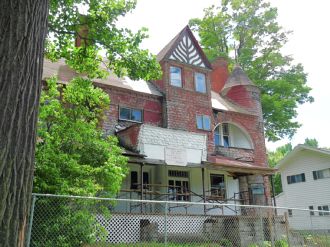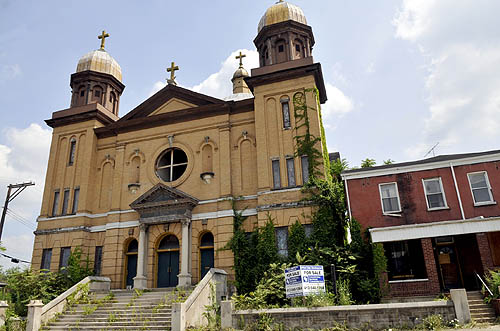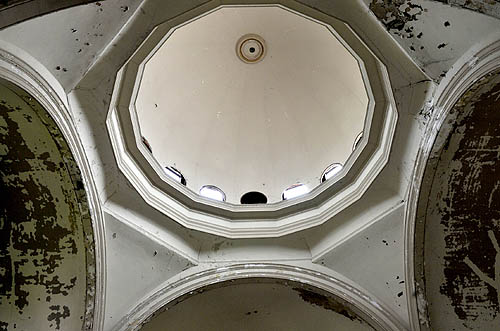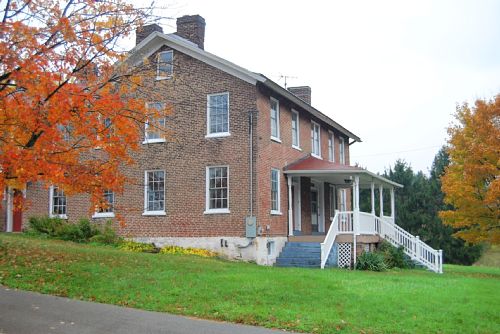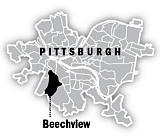
Category Archive: Easements
-
Historic John C. Plumer House Protected by Preservation Easement
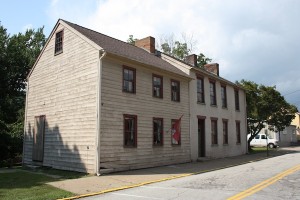 The Mon Valley Initiative (MVI) has donated a preservation easement to the Pittsburgh History & Landmarks Foundation to ensure the preservation and protection of the historic John C. Plumer House in West Newton, Pennsylvania, in Westmoreland County.
The Mon Valley Initiative (MVI) has donated a preservation easement to the Pittsburgh History & Landmarks Foundation to ensure the preservation and protection of the historic John C. Plumer House in West Newton, Pennsylvania, in Westmoreland County.Listed on the National Register of Historic Places in 1979, the original 2½-story frame house was completed in 1814 as the home of John Campbell Plumer and his new bride, Elizabeth Peaire. A brick addition was constructed in 1846.
A preservation easement is a voluntary legal agreement made between a property owner and a qualified preservation organization to protect the exterior of a historic site in perpetuity. It is recorded on the deed and filed in the Recorder of Deeds office. This easement would not have been possible without the partnership of a number of parties and a timely phone call.
“About a year ago, Ben Markle, president of the West Newton Historical Society, notified us that there was a possibility that the Plumer House might be demolished,” said PHLF President Arthur Ziegler. “When we contacted the Borough of West Newton, the owner of the property, we learned they were open to preserving the property if they could relinquish their ownership of it.”
Knowing how important the Plumer House could be to the economic revitalization of the Borough, PHLF began working with Downtown West Newton, Inc., a local non-profit group dedicated to the improvement of West Newton’s Main Street District. The organization already had a project underway with MVI. This project was a focused marketing initiative to promote the economic growth of West Newton.
These two organizations had local connections and a deep understanding of the community’s real estate market, which allowed for a strong partnership between all of the groups involved. Because of this, PHLF elected to work with MVI rather than accept a donation of the property.
“It couldn’t have worked out better,” says George Molovich, president of the West Newton Borough Council. “After learning more about preservation easements and reviewing our options, Council decided to convey the property to MVI on the condition that they donate and endow a preservation easement to PHLF and use the Plumer House to stimulate economic development.”
To help the process, PHLF deferred MVI’s contribution to endow annual monitoring costs to assure compliance with the terms of the easement and will assist MVI in marketing the Plumer House to a new owner.
“This undertaking is a wonderful example of what happens when there is an excellent relationship between an involved local Community Development Corporation, a supportive local government and strong non-profits,” says MVI Senior Real Estate Developer Patrick Shattuck. “A year ago, there was a chance that this one-of-a-kind property might be lost. Now, it is an important part of our strategic revitalization strategy for West Newton and is already attracting outside interest to this vibrant community.”
Under the easement terms, MVI and future Plumer House owners will continue to be responsible for the maintenance and upkeep of the house, and PHLF will be responsible for monitoring the property on at least an annual basis in perpetuity to assure compliance with the conditions of the easement. No changes can be made to the exterior of the building without PHLF’s prior approval and any changes should conform to the United States Secretary of the Interior’s Standards for Rehabilitation.
While granting a preservation easement on a historic property limits what an owner may do with the exterior of that property, granting the easement provides several benefits. The first and most obvious is that the property owner has protected the historic property in perpetuity from destruction, inappropriate alteration, or development of its land. Another is that an individual or corporate easement donor may be entitled to claim a federal charitable contribution tax deduction equal to the value of the preservation easement if certain conditions are met.
For example, without the federal charitable contribution deduction and rehabilitation tax credits associated with the restoration of historic properties, projects like the Bedford Springs Resort in Bedford, PA, and the Heinz Lofts and Armstrong Cork Factory Apartments in Pittsburgh, PA, might never have been developed. A charitable contribution deduction was not associated with the Plumer transaction, however, since the donor was a non-profit organization.
PHLF holds nearly 50 preservation easements and deed restrictions on Western Pennsylvania properties, and will announce another one on September 14 during its annual donor recognition event.
Pittsburgh History & Landmarks Foundation is a 501(c)(3) non-profit organization founded in 1964 whose mission is to identify and save historically significant places; revitalize historic neighborhoods; preserve historic farms and historic designed landscapes; and educate people about the Pittsburgh region’s rich architectural heritage. More information can be found at www.phlf.org.
The Mon Valley Initiative is a non-profit community and economic development coalition currently comprised of 10 Community Development Corporations whose mission is to work together to unite communities and restore the economic vitality of the Mon Valley. Downtown West Newton, Inc., is one of the member CDCs. More information can be found at www.monvalleyinitiative.com.
HISTORIC SIGNIFICANCE OF THE PROPERTY
Born in 1788, John C. Plumer was an important pioneer who spent the early part of his life trading in commodities necessary to frontier life. Upon his return from serving in the War of 1812, he was elected captain of a troop of Pennsylvania militia cavalry raised in Fayette and Westmoreland Counties and served a term of seven years.
He was active in many phases of community life. He bought a gristmill and saw mill from his brother and grew the business into one of the largest in the area. He also purchased a mill on Sewickley Creek and built a dam across the Youghiogheny River to furnish the power. Navigation was kept open by means of a lock. When a toll bridge was built to replace the ferry at nearby West Newton, Plumer supervised its construction and was a principal stockholder.
A follower of Andrew Jackson, Plumer was elected to the State Legislature in 1830 and the State Senate in 1839. Locally, he served as a Justice of the Peace and pioneered the movement for a free school system. Retiring from business in 1866, he died July 18, 1873.
-
Jones’ Cresson Home May Avoid Razing
Saturday, November 20, 2010By Patricia Lowry, Pittsburgh Post-GazetteThe Cresson Area Historical Association, which has owned the 14-room, Queen Anne-style house since 1990, has a tentative agreement to sell it to Andrew and Carrie Dziabo, who grew up nearby and live just a few minutes away.
The tentative agreement, reached Friday, appears to have the blessing of Cresson Township supervisors, who heard the couple outline their plans at a township meeting earlier this month.
“We’re still working on it,” said Mr. Dziabo (pronounced zay-bo). “There are issues that need to be worked out, but it’s looking promising.”
The dilapidated house has been under threat of demolition since a Cambria County judge approved its razing in late 2008. Supervisors had told the historical association the house could be torn down after Sept. 30.
A member of the historical group wrote in an e-mail that the house would be sold for a nominal fee, with the new owners also paying the township’s legal expenses incurred during the long court proceedings. Mr. Dziabo referred questions about sale price to the township solicitor, who was unavailable Friday.
Mr. Dziabo grew up a block away from the Jones cottage, in a historic house that also was part of the Mountain House resort grounds. He worked with his father, civil engineer Michael Dziabo, on restoring that house, and the two plan to collaborate on this one.
While Andrew Dziabo, who works for a power company, has admired the Jones house since he was a child, it wasn’t until the historical group offered tours in the spring that he was able to see the interior.
“The house isn’t in as bad shape as I thought,” he said. “It’s actually very sturdy inside. There is some water damage that ate the plaster in a lot of the rooms, but as far as the structure goes, it seems pretty sound and sturdy. The floors don’t even creak.”
The Dziabos intend to restore the exterior and preserve as much of the interior woodwork as they can.
“The whole appeal of it to my wife and me is the character of the Victorian-style home,” he said, adding that its ornate, well-preserved foyer and staircase “would be very easy to restore. It’s just a matter of elbow grease.”
The Dziabos expect to know soon whether the Jones cottage is theirs.
“The township wants to have this issue to bed by the next [supervisors] meeting.”
-
Buying Here: Larimer
Saturday, November 20, 2010By Gretchen McKay, Pittsburgh Post-GazetteOur Lady Help of Christians in Larimer was barely 5 years old when fire ripped through it in 1905, destroying the church at the corner of Meadow and Turrett streets. The Italian immigrants who had guided its construction in 1898, though, were a resolute bunch.
Within a year they’d rebuilt the Baroque-style structure, and until it closed in 1992, Help of Christians served as a center of Italian-American religious and social life, hosting not just Catholic Masses but everything from the annual celebration in honor of St. Agnello Abate to an array of sporting activities for neighborhood kids.
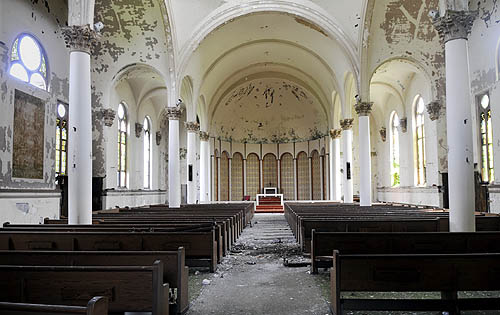
The ceiling and plaster walls have peeling paint at the former Our Lady of Help Christians church in Larimer. J. Monroe Butler II/Post-Gazette
Like many churches in the city, however, its parish aged and dwindled and was merged in the 1990s with five others to form St. Charles Lwanga parish in Lincoln-Lemington. In 1995, the Pittsburgh Catholic Diocese sold the church, which has a banquet hall in the lower level, and adjacent rectory to Heavenly Vision Ministries.
Three years ago, Heavenly Vision put 6513 Meadow St. back on the market, at first quietly through word of mouth, and then last year officially for $169,000 through Coldwell Banker Real Estate’s Fox Chapel office (www.pittsburghmoves.com; MLS No. 838378; 412-963-7655).
 Larimer
Larimer
At a glance- Website: www.city.pittsburgh.pa.us/district9/
- Size: .445 square miles
- Population: 2,602 (2000 census)
- School district: Pittsburgh Public, pghboe.net
- Enrollment: About 28,000
- Average 2010 SAT scores: (Peabody High School) 379 verbal; 410 math; 380 writing
- Taxes for a property assessed at $100,000 *: $2,870; City: $1,080 (10.8 mills); School district: $1,392 (13.92 mills); County: $398 (4.69 mills)
- Wage tax: 3 percent (1 percent to the city, 2 percent to the school district)
- Bet you didn’t know: Originally settled by Germans in the mid-1800s, Larimer was Pittsburgh’s “Little Italy” until the 1960s. It is named for railroad magnate and radical abolitionist General William Larimer, who built a manor home overlooking East Liberty along a path that would eventually become known as Larimer Avenue.
* Includes the Act 50 Homestead Exclusion, which reduces assessed market value by $15,000 for county taxes.Time has not been kind to Help of Christians, which could accommodate up to 1,000 worshippers in the nave and balcony in its heyday in the ’50s and ’60s. The amount of repairs necessary to breathe life back into the property are pretty extensive.
There is no glass in its long, arched windows and holes in the roof. The coved ceiling and plaster walls are peeling paint. Vandals have broken the pews and stolen the pipes from the organ. Carpeting is matted with dust, debris and pigeon feathers. The hand-painted frescoes that brightened the chancel are so badly faded and tarnished you almost can’t tell they were ever there. There’s no heat or water.
“People go in an ooh and aah over the architecture, but it’s a broken structure,” says Realtor Ted Harchick, who shares the “as-is” listing with Dan Boehler.
Adding insult to injury are the many thefts that have stripped the space of most everything of architectural significance. Only a handful of the dozens of original stained-glass windows remain. And it’s only because they’re too heavy to lift that looters also didn’t carry away the marble communion rails in the chancel.
Most heartbreaking is the massive circular window that crowned the front door. Somehow, the robbers managed to sneak the stained glass out of the wood framing in the stealth of night.
Vandals also have trashed the 6,000-square-foot rectory, which during Heavenly Vision Ministries’ tenure housed Family Options Foster Care, in addition to church offices. The property’s current market value is $256,400 ($172,900 for the church and $83,500 for the rectory). Taxes are in arrears on the rectory.
“It’s not for the faint of heart,” admits Mr. Harchick. “We need a risk-taker.”
On the plus side is its location in Larimer. Developments such as Bakery Square, a new “lifestyle center” in the old Nabisco plant on Penn Avenue, are helping to make one of Pittsburgh’s poorest neighborhoods attractive to national retailers and other businesses. UPMC, for instance, is planning to open a technology development center there by the end of the year, and Free People, a hip clothing boutique, follows on the heels of Anthropologie this winter. Next year, a $1.8 million, 14,500-square-foot vocational center funded by the Urban Redevelopment Authority and the Small Business Administration will open not far from the church on Meadow Street.
The Rev. Armenia Johnson, leader of Heavenly Vision Ministries, says she will be very careful in selecting a buyer for the old church.
“We want them to restore it into something that is beneficial and positive for this community,” she says.
In other words, if you’re thinking “brew house” or “night club,” it’s probably not going to fly.
Rev. Johnson, who is now associate pastor of St. James Baptist in Homewood, paid $100,000 the property in 1995. Although the Garfield native did her best to maintain the elegant building, she never had the funding she needed to properly maintain or improve it. So bit by bit, the once grand structure fell into terrible disrepair.
It’s a common fate for churches, which account for a growing number of real estate listings thanks to declining membership and consolidations. According to RealSTATS, a South Side-based real estate information company, 45 churches have changed hands in Allegheny and surrounding counties since January 2009, with sales prices ranging from $5,000 for Ambassador Baptist Church in Ross to $1.1 million for Christian Community Church in Adams.
Occasionally one will make the transition from place of worship to heavenly home. But given the high redevelopment costs, it often takes a grand idea — restaurant, performance hall, multi-unit condo development — and corporate investors to fill such a grand space. CVS, for example, bought the church in Adams. Most are purchased as-is by other religious organizations, or they languish on the market for years.
“You definitely don’t have as many players,” notes Tom Conroy of Howard Hanna Real Estate Services, who has sold so many churches for Hanna’s commercial division that he’s known as The Church Guy.
Mr. Conroy’s current listings include Harvest Baptist Church in New Kensington ($199,000; MLS No. QL102931); St. Michael Church ($250,000; MLS No. QL103962) in Munhall; and St. Mary Magdalene ($159,000; MLS No. QL103653) in Homestead.
Financing, zoning and parking all can be challenges. Many older churches were built in walkable residential areas that prohibit commercial enterprises. Former parishioners add to the difficulty. Even after religious artifacts have been removed and the building is just a building, some stay emotionally attached.
“Significant events take place there,” says Mr. Conroy. “Marriages, baptisms, funerals.”
-
T & T Hardware Closing After 74 Years
Friday, November 19, 2010By Emily Gibb, Pittsburgh Post-Gazette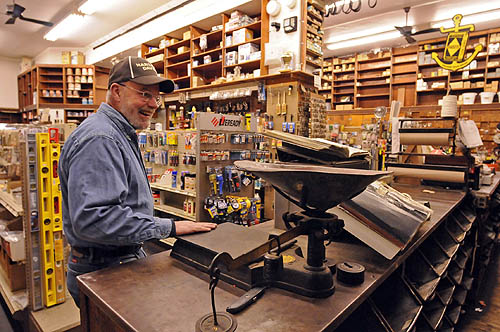
Manager Mark McNally is winding down business at T & T Hardware, a fixture at 2114 East Carson St. on the South Side since 1936. Owned by the Tumas family since its founding, the store has found it impossible to compete with big-box retailers. The scale, which has weighed countless nails and screws for sale by the pound, will remain with the Tumas family. Everything else will be marked down 50 percent Monday morning. Bob Donaldson/Post-Gazette
Pull open the solid wood door with its weathered red paint, walk into T & T Hardware Co. Inc. on the South Side and it’s a bit like stepping back in time.
Wooden shelves line the walls, some all the way to the ceiling, along with rows and rows of little wooden drawers full of screws, nuts and bolts behind a wooden counter along the back. Power tools almost seem out of place in their wood and glass displays.
But next week, after fighting off hard times the last few years, the hardware store fixture on Carson Street begins the process to shut its doors for good.
The “mom and pop” store has too much remaining inventory to liquidate or auction off yet, so beginning Monday, everything is 50 percent off the original price, said manager Mark McNally, 55, of Mount Washington.
They are waiting to see how long it takes to sell most of their inventory to set an exact closing date. This week, they’re just trying to get everything out on the shelves.
Stanley Tumas opened T & T Hardware in 1936. After he retired in the late 1980s, his son, Michael Tumas, took over ownership of the store.
It has stayed in the same spot for the last 74 years, expanding to the side and to the back as the years went on. It was a work in progress until the ’80s, Mr. McNally said.
He says they’ve always had a reputation as the place to go for “odd stuff that no one else has,” like specific plumbing parts, nuts, bolts or screws.
Since he began working at a hardware store in Mount Washington as a teenager and then managing T & T Hardware for the last 15 years, Mr. McNally has seen many changes in the business.
Part of the challenge comes from “big box” stores, like Home Depot. “They’re key why these stores are going,” he said.
Competing with a Lowe’s only five miles away has been difficult.
“It’s just too close. I can show you on my books when they opened,” he said.
Besides competing with large chains, they are competing with the economy as well.
A lot of their business used to come from commercial contractors, but if the contractors don’t have jobs to do, they won’t be coming the hardware store for supplies.
On top of the struggling economy, the South Side is a changing neighborhood.
“For a store like this, the neighborhood has to support it,” he said.
But most people in the neighborhood now rent their houses. Generally, renters aren’t in need of hardware supplies when they can just call their landlord to take care of things.
Saturday used to be the busiest day of the week for a hardware store, Mr. McNally said. Customers who had the day off work would buy their home improvement supplies in the morning. If they were having problems, they would return around noon. If they were really having problems, they would be back again around 3 p.m., Mr. McNally said.
But last year, he started closing on Saturdays — they didn’t have enough weekend business to make it worthwhile anymore.
At one time there were four or five hardware stores just on the South Side, but, he says, “times change. I understand that.”
As Mr. McNally starts a new phase, he has to say goodbye to more than a store and a building.
“The people, without a doubt — that’s what I’m going to miss the most. After 15 years you make good, good friends,” he said.
-
South Side Hardware Store Ends 74-Year Run
By Craig Smith, PITTSBURGH TRIBUNE-REVIEW
Wednesday, November 17, 2010Pittsburgh’s South Side was a different neighborhood in 1936 when Stanley J. Tumas scraped together $800 to open his T&T Hardware store on East Carson Street.
“It was an old ethnic neighborhood. People took pride in that neighborhood,” said his son, Mike Tumas, 59, of Coudersport, Potter County, who has decided to close the store his father started 74 years ago.
The hardware store became a staple of the neighborhood anchored by the nearby J&L Steel mill, he said.
“Guys would get laid off. Their wives would say, ‘You’re painting the house,’ ” Mike Tumas said. “We did well. We did a good business.”
And the business grew over the years. It doubled in size when Stanley Tumas knocked down a wall separating the building.
Father and son worked hard.
“You spent vacations, days off, working at the store,” Mike Tumas said. “That was our life.”
But T&T and other neighborhood hardware stores found it hard to compete with big box chain stores and a changing market. Modernization — fax machines and computers — proved difficult for veteran shopkeepers used to sales receipt books with 50 pages in them, Mike Tumas said.
“My dad’s idea of a fax machine was to hand you a receipt and say, ‘Run this down the corner,’ ” Mike Tumas said.
Three people will lose their jobs when T&T closes before the end of the year. Tumas said he tried to sell the business but found no takers. He plans to sell the building.
“A lot of commercial accounts told me they were leaving Pittsburgh and Allegheny County because of the taxes,” he said. “What commercial businesses are on the South Side anymore?”
Hardware stores used to dot the area — three in Mt. Washington, two in Allentown, four in the South Side.
“We ran longer than most,” said Mark McNally, T&T’s manager.
It was an uphill run.
Home Depot said its sales during the third quarter totaled $16.6 billion, a 1.4 percent increase from the third quarter of fiscal 2009. Lowe’s Cos. Inc. reported sales for the quarter increased 1.9 percent to $11.6 billion, up from $11.4 billion in the third quarter of 2009.
“It’s hard to fight the big guys — they are so big,” said Duquesne University marketing professor Audrey Guskey. “These are family owned, the money stayed here, and the owners poured their hearts and souls into the business.”
The inventory at T&T Hardware, kept in homemade wooden drawers and metal bins, will be liquidated before the store closes, Tumas said.
-
Abel Colley Tavern Helps Preserve Fayette County History
Sunday, November 14, 2010By Marylynne Pitz, Pittsburgh Post-GazetteUNIONTOWN — Five miles west of this Fayette County seat stands the Abel Colley Tavern, a red-brick beacon of hospitality to travelers along the National Road during the 1800s.
Just one mile from Searight’s Toll House, the tavern was known for its moderate prices and hearty clientele of wagoners, who swapped many a tale over Monongahela Rye in its barroom.
By this time next year, it will be a place for even more stories as it becomes the Fayette County Museum. With 6,500 square feet, the restored building will have office space on the second floor for the Fayette County Historical Society, which currently has no regular space to meet; its members often house artifacts in their homes.
The last people to live there, Sue and Frank Dulik, left the property to Virginia and Warren Dick, who donated it to the society.

Jeremy S. Burnworth, president of the Fayette County Historical Society, stands inside the front door of the former Abel Colley Tavern, which has been restored and will become the society's new home next year. Marylynne Pitz
Jeremy S. Burnworth, the society’s 31-year-old president, is a Markleysburg native who has developed a passion for Fayette County’s rich history. At a convention in September of the American Association of State and Local History, Mr. Burnworth got excited when he learned about standardized software made by the Rescarta Foundation in Wisconsin that allows historical societies to photograph, log and archive materials.
“What a perfect opportunity to do it right from day one,” he said.
An advisory committee will oversee the museum’s operation and at least 30 people have volunteered to help staff the museum and toll house. One of Fayette County’s best-known residents has also pitched in. At an opening ceremony in July, the temperature rose to 99 degrees in the 19th-century building. Joe Hardy, the 84 Lumber tycoon and former Fayette County commissioner, offered afterward to pay for a new heating and cooling system.
One person who knows the building well is Tom Buckelew, a retired physiology professor from California University of Pennsylvania. He figures he has spent 1,500 hours working on restoring the former tavern.
“It had been modernized with drop ceilings and acoustic tile ceilings,” Mr. Buckelew said, adding that many of the rooms had four or five layers of wallpaper that had to be stripped before repainting with period-appropriate colors.
Just inside the front door is a large foyer with a staircase. On the ceiling is some of Mr. Buckelew’s best craftsmanship — a hand-carved ceiling medallion that lends elegance to the new chandelier.
“I roughed out the medallion with a band saw and then just carved the rest. That was about two weeks, three hours a day,” he said.
On the second floor is a large ballroom where Mr. Buckelew painted an intricate, ruglike pattern of mustard, brick red and chocolate brown. It’s actually a centuries-old trick for disguising uneven floors.
“It was a way of capitalizing on bad design,” he said, adding that the front part of the ballroom is probably an inch lower than the back portion. “That was a feature that a lot of people adopted in the early 19th century. In lieu of rugs, you paint a rug on the floor.”
A team of inmates from SCI-Greene spent two weeks hanging dry wall in the building. A new ceiling was attached to a plaster-and-lathe one in the second-floor ballroom. Then, Mr. Buckelew put up crown molding with the help of another volunteer, Bill Zin. Joe Petrucci, a township supervisor in Menallen, donated 400 board feet of molding.
“That ceiling is tied to irregular joists. So the ceiling naturally has some dips in it, high spots and low spots,” Mr. Buckelew said, adding that the crown molding camouflages the dips.
The building, done in a vernacular Greek Revival style, was added to the National Register of Historic Places in 1995. Jerry Clouse, who nominated the building for federal designation, dates the structure to around 1835. He said two architectural features signify its use as a tavern: the kitchen ell with a double-stacked porch and two front doors, one of which opens into the barroom.
At least one historian believes it may have been a home much longer than it was a tavern. Ronald L. Michael, a retired anthropologist who excavated around the nearby Peter Colley Tavern in 1973, believes Abel Colley’s famous tavern stood on the opposite side of Route 40, partly because there was once a well on that property which would have provided water for travelers and horses.

Abel Colley owned a Fayette County tavern just outside of Uniontown on U.S. Route 40. Volunteers have restored the 19th-century building during the past year. The former tavern will become the Fayette County Museum next year and also will provide office space for the Fayette County Historical Society.
The building that locals know as the Abel Colley Tavern, Dr. Michael said, is more likely the house he built after making his fortune in the hospitality business, then retiring. Mr. Burnworth agrees but still treasures its history.
“It was probably only a tavern, if ever, for a very short period of time,” he said. “He died a few years after we believe it was built. Most likely, it was his home.”
-
Buying Here: Beechview
Saturday, November 13, 2010By Kevin Kirkland, Pittsburgh Post-Gazette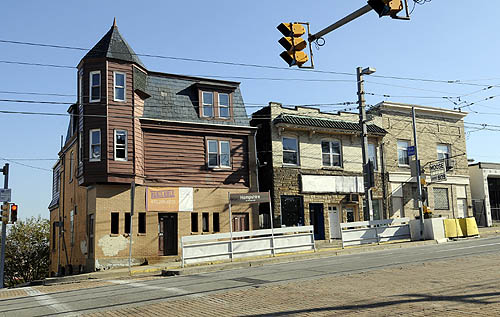
The city's Urban Redevelopment Authority has foreclosed and put on the market four buildings -- 1600, 1601, 1602 and 1619 Broadway Ave. == with hopes of enticing developers to invest in this business district and begin its turnaround. Larry Roberts/Post-Gazette
The panoramic views of the South Hills from the third-floor balcony of 1600 Broadway Ave. are a sight for sore eyes — especially if you live in Beechview.
For the last five years, residents of that city neighborhood and riders on the LRT have had to look at mostly shuttered storefronts on Broadway that were bought — then abandoned — by investor Bernardo Katz. The city’s Urban Redevelopment Authority has foreclosed and put on the market four buildings — 1600, 1601, 1602 and 1619 Broadway Ave. — with hopes of enticing developers to invest in this business district and begin its turnaround.
“Beechview is a very cool neighborhood,” said URA Director Rob Stephany. “I think its proximity to the T makes it interesting.”
Mr. Katz defaulted on millions of dollars worth of mortgages and more than $700,000 in loans from the URA that he used to buy these and other commercial properties in Beechview, Oakland and Mt. Lebanon. He fled to his native Brazil in December 2007 and was charged in absentia last year with federal wire and mortgage fraud.
Although most of the buildings were left to deteriorate, Mr Katz worked on the exterior and interior of the first floor of 1600 Broadway and briefly opened a Mexican restaurant there. The largest of the four, it’s now priced at $194,800. The newer storefront reflects its early 1900s construction while the second and third floors have a total of five apartments and another in the basement, with walkout access on Hampshire Avenue. The URA gutted the apartments to the plaster lathe, removing asbestos and all mechanical systems.
“That’s the way developers want it,” said Dave Majcher, URA senior construction coordinator.
Also gutted was the adjoining 1602 Broadway ($43,000), a former bar that has a new roof and a rickety rear addition that the URA says should be removed. Across the street is 1601 Broadway ($130,000), another former bar with a turret and a few architectural details that survived previous remodels — an original staircase and a columned fireplace mantel on the second floor. The views from its second- and third-floor windows are classic Pittsburgh, with small houses clustered along hilly streets.
A half-dozen storefronts separate 1601 from 1619 Broadway ($70,000), a small former video store with an intact three-bedroom apartment behind.
“It’s perfect for a small business owner,” Mr. Stephany said. “Someone could be in at a reasonable cost.”
The other three buildings, however, are suitable only for developers, he said. A feasibility study the URA commissioned last year estimated exterior and interior renovation costs at $588,799 for 1600 Broadway, $409,586 for 1601 and $457,866 for 1602.
“These are probably $600,000 events,” Mr. Stephany said.
Even with façade grants and streetscape loans, buyers would still be looking at construction loans of at least $400,000 for each building. Everything is not bleak, however. IGA plans to reopen the shuttered Foodland next to 1602 Broadway, and brothers Kevin and Adam Costa have purchased 1603 Broadway to open their Crested Duck Charcuterie, “an artisanal meat market.” At least initially, the apartments may be the hotter part of the properties.
“I do think the first floors will come,” Mr. Stephany said. “I’m not sure they will come first.”
Susheela Nemani-Stanger, a URA project development specialist, believes loft apartments would suit college students who appreciate their proximity to mass transit.
“They would be perfect for students from the Art Institute or Culinary Institute,” she said.
For more information on 1600, 1601, 1602 or 1619 Broadway Ave., Beechview, call 412-255-6612 or go to www.buyintheburgh.com.
SALES SNAPSHOT16TH WARD/SOUTH SIDE 2009 2010 SALES 138 147 MEDIAN PRICE $45,000 $62,000 HIGHEST PRICE $505,000 $380,000 17TH WARD/SOUTH SIDE 2009 2010 SALES 143 134 MEDIAN PRICE $121,250 $137,000 HIGHEST PRICE $800,000 $595,000 18TH WARD/MOUNT WASHINGTON 2009 2010 SALES 141 137 MEDIAN PRICE $12,000 $13,000 HIGHEST PRICE $750,000 $669,000 19TH WARD/BROOKLINE 2009 2010 SALES 462 467 MEDIAN PRICE $65,000 $68,000 HIGHEST PRICE $625,000 $465,000 20TH WARD/WEST END 2009 2010 SALES 245 208 MEDIAN PRICE $33,000 $31,800 HIGHEST PRICE $200,000 $255,000 29TH WARD/CARRICK 2009 2010 SALES 121 148 MEDIAN PRICE $49,000 $45,000 HIGHEST PRICE $133,000 $147,500 30TH WARD/KNOXVILLE 2009 2010 SALES 58 54 MEDIAN PRICE $9,900 $10,100 HIGHEST PRICE $77,000 $55,000 31ST WARD/LINCOLN PLACE 2009 2010 SALES 45 72 MEDIAN PRICE $66,000 $63,000 HIGHEST PRICE $147,400 $335,000 32ND WARD/OVERBROOK 2009 2010 SALES 115 119 MEDIAN PRICE $67,000 $73,000 HIGHEST PRICE $226,000 $229,550 MOUNT OLIVER 2009 2010 SALES 58 55 MEDIAN PRICE $16,201 $20,000 HIGHEST PRICE $79,500 $76,500 WEST HOMESTEAD 2009 2010 SALES 17 23 MEDIAN PRICE $43,100 $22,000 HIGHEST PRICE $169,900 $125,000 Beechview
At a glance- Website: www.beechview.org
- Size: 1.46 square miles
- Population: 8,772 (2000 census)
- School district: Pittsburgh Public (pghboe.net)
- Enrollment: 25,326
- Average 2010 SAT scores: 425 verbal, 446 math, 423 writing
- Taxes on a property assessed at 100,000 : $2,870; City: $1,080 (10.8 mills), school district: $1,392 (13.92 mills), county: $398 (4.69 mills), wage tax: 3 percent (1 percent to the city, 2 percent to the school district)
- Claim to fame: Named for the many beech trees found on its hillsides, Beechview (incorporated as a borough in 1905 and annexed to the city four years later) has the steepest street in hilly Pittsburgh, and quite possibly the world. Canton Street has a grade of 37 percent — that is, it rises 37 feet per 100 feet of run. So steep is the bottom half, that residents aren’t supposed to drive down it.
-
Schwartz Market Alive and…Well, Hoping to Sell
Wednesday, November 10, 2010 08:00 AMStaff Blogs by the Pittsburgh Post-Gazette
Written by Diana Nelson Jones
Since I reported in May that Schwartz Market had a buyer, shoppers have assumed that the little store on East Carson Street had gone out of business.
Not so! Schwartz Market at 1317 E. Carson, is alive and wants you to know it will remain alive until a buyer actually comes through. An IGA grocer had signed a letter of intent in May but backed out of the deal because the building needed upgrades that the building owners have not made.
The building is owned by family of the founding grocers, who once operated six Schwartz Markets in the city. The South Side market, which is on Facebook, has been in operation since the 1920s.
Marty and Audrey Dorfner and Rick and Donna Stanton bought the business in 1985 and have operated it continuously since.
“My goal is to retire after 54 years in this [grocery] business,” said Marty, who has another grocer showing interest in the store.
Until then, said Donna, “We will be here because we want the neighborhood to be served.”
They are gearing up to meet your holidays needs with the kielbasa and sausages for which they are known.
My article was based on information that made the deal appear to be a sure thing. A lot of articles in the paper are anticipatory, such as economic development groundbreakings on ground that three years later have yet to see another shovel.
It’s one thing when there’s nothing there anyway; it’s another when a business suffers as a result. Our city neighborhoods need small retailers; remember to support them in these lean times.

